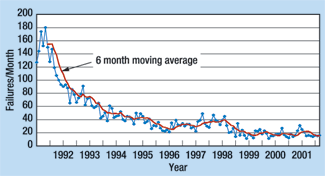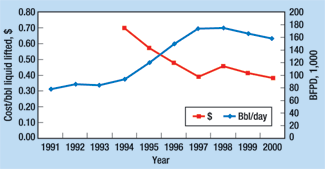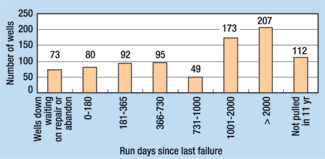Holistic producing-well improvement reduces failures/ servicing costs
Holistic producing-well improvement reduces failures / servicing costsKent Gantz, * Schlumberger IPM, Midland, Texas Bottom line. Schlumberger IPM used the Producing Well Improvement Process (PWIP) in a Permian basin project with 900 active producers near Pennwell, Texas. Excessive well failures result in lost production, elevate lifting costs and can lead to premature abandonment. Through using PWIP since 1991, well-failure frequency has been reduced by a factor of about10, from 2.5 to 0.27 failures per well per year. Well-servicing costs have been reduced from $700M to $270M, a threefold improvement. The PWIP process. PWIP is a systematic process by which well-production optimization and wellbore equipment-repair procedures are implemented and improved over time to provide the longest economical well life. The primary goals are to increase profits (not necessarily production rates), reduce long-term well-service / operational costs, improve the general operating situation for wells after repair, and improve the operational situation for wells that have not yet failed. The process recognizes that well servicing is a holistic system, involving team work, with decisions made based: 1) on data, governed by economic parameters that follow business plans; 2) implemented by trained well service crews and supporting service technicians, with post-well-service reviews, analyses and adjustments; and 3) utilizing automatic operations with routine / periodic surveillance. Field results. The value of this holistic approach lies in its results. In this 900-well, producing-well project, over an 11-yr period, average monthly well-failure frequency has been reduced tenfold, from 180 to 18 well failures per month, Fig. 1. Since 1994, yearly average lifting costs have dropped from $0.70 to less than $0.40 per barrel (at year-end 2000), representing more than a 45% reduction, Fig. 2. Fig. 3 illustrates the "current" run days since the last failure for a total of 881 wells. Remember, before PWIP, there were 2.5 failures per well per year. Now, 56% of the wells have run more than 1,000 days (or nearly three years) since the last failure, i.e., the total of the last three columns in Fig. 3.
Holistic system review. Each component of the well system is first analyzed individually, then together as a whole system, prior to repairing or changing it. Possible contributions of previous well work to current wellbore problems, tubing and rod run lives and conditions, and production rates and lift equipment are determined. Well corrosiveness and chemical treatment rates are reviewed. Bottom assemblies are reviewed, i.e., gas separation, seating nipple placement, tubing anchor and joint above the seating nipple. Sucker rods and sinker bars are analyzed to ensure that the lightest effective weight is obtained, but load stresses are still kept relatively low. Pumping units are adjusted to run as slow, and with as few on/off cycles as possible, but still attain pumped-off conditions to help corrosion-treating effectiveness. Guidelines are set for chemical treating for each type of well, depending on fluid level, production rates and oil/water cuts. Treatment rates and coupons are compared to rod and tubing sample conditions for effectiveness. If ineffective, the treatments or materials are improved. If high fluid levels are hindering the treatments, then larger lift equipment is sought to reduce the fluid level. Teamwork and buy-in, data-based decision making. An engineer, a field foreman, the rig supervisor, the chemical vendor representative and a pump-supplier representative all contribute to the repair plan. Economic alternatives are evaluated, and final plans are made and approved by all, which helps guarantee buy-in. Decisions are based on data, not opinions. A well is not pulled until a data package (the Pre-Pull) is completed and approved. Considerable effort is put into the diagnostic portion of the well failure. The well-repair procedure will tend to follow the direction of the diagnosis and so will the cost estimate and economics, therefore, accuracy is important. Tools used to diagnose the failure include dynamometers and acoustic-fluid-level analyzers. Additionally, hydraulic pressure tests of tubing and rod-pump action are recorded on pressure charts. Diagnostic flow diagrams and concepts are followed to increase the likelihood of a correct diagnosis. Beam-lift analysis software and laptop computers are used to carry the diagnosis further so that a complete system review can be performed. Other data resources include traditional well files and chemical and pump vendor information. Routine operational data gathered includes well-production tests, routine fluid-level shot data, corrosion-coupon data and water / scale (or solid samples) analyses. Information available to the industry via technical symposiums or forums is scanned for new ideas, and a lot of networking and interfacing with other experts is done as often as possible. Databases were created, and software for managing data was acquired. At first, the databases were merely spreadsheets; later, more sophisticated formats were developed. Most of the technical equipment used was bought off-the-shelf from specialized companies. Economic parameters follow business plans. Managers like PWIP because it sets the economic parameters that field work must meet. In a volatile oil market, the quick restoration of a repair investment is fundamental. For production that is "down" due to a well failure, the philosophy applied foremost is: "It is not the rate of return that is important, but when the money invested is returned." So restoring it under strict economic guidelines becomes the guiding light. Current market oil/gas prices and operating costs are input to an economic evaluation, and the investment must pay back at least 100% of the cost, within six months or less. If it can meet these parameters at current prices, a well will be repaired – otherwise, it will be abandoned temporarily. Thus, the effort to fix it right the first time is balanced by economic constraints. The annual expense budget also must be met, and not exceeded. Thus profit, not production or failure-rate reduction, guide the PWIP. Pre-planned well service procedures. Repair plans are made to accommodate the specific situation, plus address other possibilities such as stimulation. A written procedure, with economic evaluation parameters and the supporting data, is put together. This document is called the "Pre-Pull" plan. It provides complete information to the rig supervisor and rig operator. And it provides a foundation for future re-evaluation. This process ensures initial agreement between design parties and the authority or operational parties. Usually, signatures are obtained from the engineer and field foreman, then the superintendent approves the financing. At any time, a job can be changed, but any scope change or change in costs due to unforeseen circumstances is evaluated prior to the end of the job and rerun through the Pre-Pull approval process before implementation. No money is spent beyond the original authorization, without giving management the opportunity to say no. Trained well-service crews and supporting services technicians. Implementation of the repair work is led by the wellsite supervisor. Well-service rig pushers, pump-repair-vendor reps, chemical-supply-vendor reps, etc., are coordinated to implement the plan and logistics. The crews chosen to implement the work are not necessarily the cheapest. Quality service requires quality service persons and tools. Low bidding may be just as destructive as cutting the chemical treatments out of the budget. If one is fortunate, the rig crews will remain the same, day in and day out. Untrained new crews, or changing well service companies, frequently can open the door for well-servicing errors. Speed of service is also a factor, since crews that are pushed too hard and made to "run too fast" will have tendencies to not handle equipment correctly, causing unnecessary secondary pulls. They will also tend to have high injury rates. Post well service review, analysis and adjustments. Once a well is repaired, the process requires follow up. Inevitably, someone will still make a mistake and something will be left undone. Post well-failure reviews are thus conducted to review the actual proceedings. The performance of the lift equipment is compared to post-service well tests, fluid levels and dynamometer analyses. Root causes of the failure are reviewed and documented. If adjustments need to be made, orders are given. Depending on the orders, they may be implemented immediately or postponed until further data is gathered, but they are documented and follow-up reviews are made. Where available, automated well-control equipment is utilized to monitor wells, day to day. Some wells are monitored by radio telemetry. Lease operators and technicians monitor repaired wells until they become stable. Hopefully, the well will operate efficiently, and run for a long time, making a marginal well become profitable. Run speeds are minimized, fluid pounding and tagging are avoided, and on/off cycles are minimized. Since well performance changes with time, technicians periodically review each well. In conclusion, the PWIP provides the consistency needed to learn and improve. It gives the customer the opportunity to say no in advance of committing its resources. It requires buy-in, not just compromise. Applied consistently over time, it does reduce long-term well service costs and thereby enhances profitability. For a more comprehensive version of this article see: www.pttc.org. PTD
|
|||||||||||||||||||||||||||
- Shale technology: Bayesian variable pressure decline-curve analysis for shale gas wells (March 2024)
- What's new in production (February 2024)
- Prices and governmental policies combine to stymie Canadian upstream growth (February 2024)
- U.S. operators reduce activity as crude prices plunge (February 2024)
- U.S. producing gas wells increase despite low prices (February 2024)
- U.S. drilling: More of the same expected (February 2024)
- Applying ultra-deep LWD resistivity technology successfully in a SAGD operation (May 2019)
- Adoption of wireless intelligent completions advances (May 2019)
- Majors double down as takeaway crunch eases (April 2019)
- What’s new in well logging and formation evaluation (April 2019)
- Qualification of a 20,000-psi subsea BOP: A collaborative approach (February 2019)
- ConocoPhillips’ Greg Leveille sees rapid trajectory of technical advancement continuing (February 2019)





